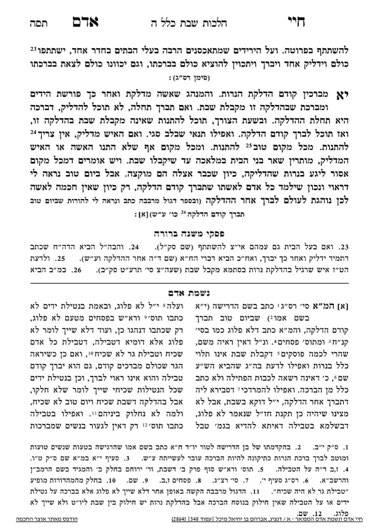We are continuing in siman 11. The Chayei Adam will now discuss hadlakas neiros on Yom Tov. Whereas on Shabbos, kabbalas Shabbos may preclude a person from lighting neiros, on Yom Tov, even though one cannot create a new fire, one may transfer a flame from a preexisting fire. If so, on Yom Tov, we should go back to the preferable situation, and a woman should make the bracha on the neiros before lighting them. On Shabbos, if the bracha causes the woman to create a kabbalas Shabbos, if she makes the bracha before lighting, she can no longer light. On Yom Tov, even if she has accepted Yom Tov with her bracha, there is no issue with transferring fire on Yom Tov, so she can still light.
Therefore, the Chayei Adam writes that it seems to him it is appropriate on Yom Tov for a woman to make the bracha before lighting. However, the reason women do not generally do so is out of concern that they will get confused, and possibly make the bracha on Shabbos before lighting, which may be a problem. Therefore, he suggests that maybe it is better to leave things alone in order not to confuse the women.
There is a story behind this halacha. Rav Yehoshua Falk was a talmid of the Rema, and wrote the Prisha and Drisha on the Tur, and the Sema on Shulchan Aruch Choshen Mishpat. In the introduction to the Drisha, the son of Rav Falk writes that his mother (the Drisha’s wife) pointed out that on Yom Tov, a woman should make the bracha before lighting the neiros, as we just learned. The Magen Avraham quotes this, and writes “ain chochma le’lashim”. Some misunderstand that he is poking fun at the wife of the Drisha, saying that she does not know what she is talking about. Rather, he is referencing this point of the Chayei Adam, that the Drisha’s wife was learned, and understood the subtle differences between Shabbos and Yom Tov, but most women were not learned. Many did not know how to read, and were not given the opportunity to go to school and learn. They did not have teachers in halacha, but would just follow what their mother did. The Magen Avraham is concerned that if we switch between Shabbos and Yom Tov, it will only cause confusion.
Nevertheless, the Dagul Meirevava, quoted in the Mishnah Berurah, suggests that a woman should switch the order on Yom Tov. However, if a woman has a minhag to follow the Magen Avraham, she may rely on it.
The Magen Avraham brings up the concept of lo plug, that when Chazal create enactments, they create them in a way that they have minimal differentiations. The Dagul Meirevava responds that it does not apply over here, as the Drisha’s wife already points out that we see by neiros Chanukah that we make the bracha before lighting. If so, we can conclude that each bracha related to lighting neiros is looked at separately (one for Shabbos, one for Yom Tov, one for Chanukah). Therefore, the Mishnah Berurah concludes that it is appropriate on Yom Tov to make the bracha before lighting, in order for the lighting to be over le’asiyasan.
Summary
- On Yom Tov, preferably a woman should make the bracha on the neiros before lighting. If she is concerned she will get confused on subsequent Shabbosos, she can make the bracha after lighting, as she does on Shabbos.



